The idea of an action-adventure story has existed for as long as literature. From the Epic of Gilgamesh to triple-A video games, the action-adventure plot is reinvented in several forms of media every day. Readers can strive to reach home with Odysseus, fall through the looking glass with Alice, or battle the harsh atmosphere of Mars with Mark Watney.
And there’s still plenty of adventure to be had! Plottr’s Action-Adventure Plot Template can help you craft your ideas into a thrilling, exciting story for your readers, viewers, or players.
What is the Action-Adventure Plot Template?
The Action-Adventure Plot template is loosely based on Joseph Campbell’s Hero’s Journey, with certain steps renamed to match common elements you’ll see in adventures. As with many templates, there are some steps you won’t see in every story, but the bare bones remain the same.
Put simply, the timeline looks like this:
- A hero sets out from their home to discover a treasure.
- They travel to new lands to find this treasure.
- Along the way, they encounter enemies and allies, face setbacks, and receive assistance.
- They might fall in love with a “damsel in distress” (a common trope) or get entangled with a femme fatale.
- In the end, they return home — with or without the treasure — a changed person.
Who is the Action-Adventure Plot Template for?
Spy novelists, video game designers, children’s and YA authors, and fantasy authors will love this plot structure, to name a few.
Examples of adventure stories range from Alice’s Adventures in Wonderland by Lewis Carroll to The Hunt for Red October by Tom Clancy.
Any story where action, rather than ideas, is the focus, can use this template.
Keep in mind that the plot points don’t need to be taken literally. Your hero can be a young girl, a stray cat, or a world-weary spy. The treasure can be anything from a literal treasure, as in pirate stories, to something more figurative — like finding a way home, such as in Homer’s The Odyssey or the video game Stray.
The treasure can also be subverted, such as destroying the One Ring in Tolkien’s The Lord of the Rings, or scattering a family member’s ashes in the game God of War (2018). The damsel may be a woman to be rescued or any person who needs the hero’s help.
Plot points of the Action-Adventure Plot
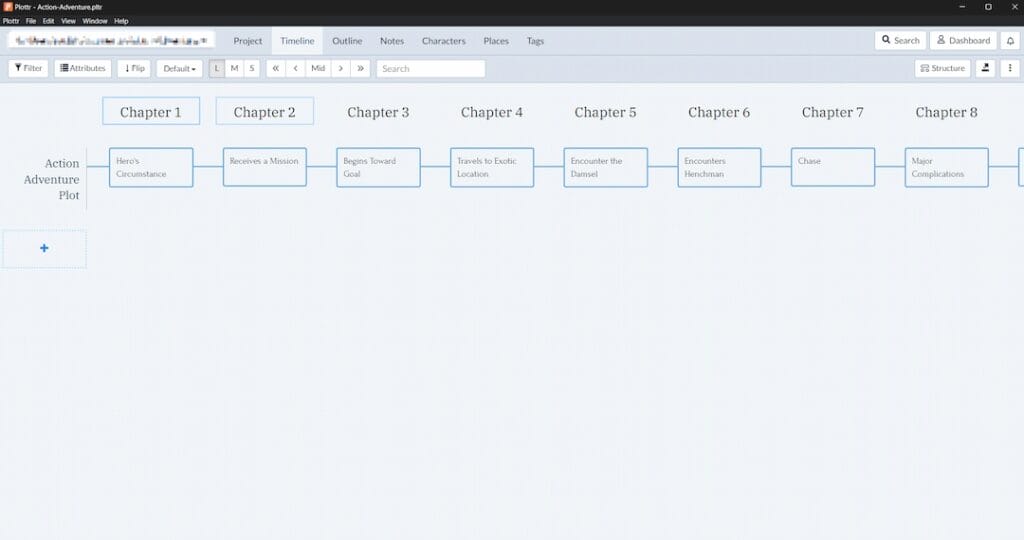
Act 1
Act 1 in the Action-Adventure Plot Template is approximately the first 25% of the story and, by default, contains 5 beats (or scenes). Let’s explore this with examples from Tolkien’s The Hobbit.
Beat #1: The Hero’s Circumstance
This scene establishes the hero’s ordinary world, as well as who the hero is. Create sympathy for the hero so your reader is willing to go along with them on the adventure. This section should be approximately 8-10% of the story.
Using J.R.R. Tolkien’s The Hobbit as an example, we start with Bilbo Baggins, enjoying his morning pipe. His life is quiet, predictable, and comfortable. When the wizard Gandalf the Grey comes along, Bilbo is polite but disinterested because Gandalf’s presence usually means trouble is afoot.
Beat #2: Receives a Mission
The inciting incident. This beat should occur at approximately the 8-12% mark. This is what pushes the hero into the adventure, whether by circumstance, the hero’s own choice, or because they’ve been given an assignment by a superior.
Thanks to a mark Gandalf left on Bilbo’s door, a party of dwarves gathers at Bilbo’s house for dinner. They sing and tell tales of their lost ancestral home, the Lonely Mountain. Gandalf tells them Bilbo is to be the “burglar” in their quest to win back the Lonely Mountain from the dragon Smaug, which the dwarves ridicule. Bilbo decides to join the company to prove them wrong.
Beat #3: Begins Toward Goal
Next, the hero takes their first steps toward their goal. They make a plan and possibly meet an ally or allies. The first small plot twist could take place, and the stakes of the plot heighten. This beat takes place about the 12-15% mark.
The company begins its journey from the Shire to the Lonely Mountain. Along the way they encounter enemies in the form of trolls, and allies in the form of Elrond and the elves.
Beat #4: Travels to Exotic Locations
In the middle of Act 1, the hero begins their mission and prepares to follow through with their plan. In doing so, they travel to a new location, where they must locate something or someone that will help with their mission. Far from home and possibly in the realm of the villain, the hero is now in danger and the dramatic tension is heightened. This beat takes place at the approximate 20% mark of the plot.
The company attempts to cross the Misty Mountains. They take shelter in a cave during a snowstorm, where their ponies are stolen by goblins, who then take the company prisoner. They are rescued by Gandalf, but Bilbo is left behind. While he is in the goblin’s cave, Bilbo finds a gold ring and is compelled to take it for himself.
Beat #5: Encounter the Damsel
This beat occurs at approximately the 25% mark of the plot and marks the end of Act 1. While preparing to put their plan into action, the hero meets the damsel, who may be an ally or an enemy — or may play a more ambiguous role in the story.
As Bilbo tries to find his way out of the cave, he encounters a strange creature named Gollum. The two of them play a game of riddles, the stakes being Gollum will guide Bilbo out of the cave if Bilbo wins, or Gollum will eat Bilbo if Gollum wins. Bilbo cheats with his final riddle and uses the ring’s invisibility magic to get past Gollum and rejoin the company.
Act 2
Act 2 comprises about 50% of the story, taking us from 25% to 75% of the plot.
Beat #6: Encounters Henchmen
This beat takes place around the 30% mark. In this scene, the tension should continue rising and the stakes become even higher. The risk to the hero increases.
You’ll also want to depict how the villain becomes aware of the hero and sends a henchman to deal with them. Obstacles threaten the mission. Allies or adversaries switch sides. The hero learns new information that changes their goal, their allies or adversaries, or their resources.
As the company continues through the forest, Gandalf tries to hurry the dwarves along so that they are out of the woods before sundown, when the goblins will come out of their cave.
Beat #7: Chase
The hero, having escaped the henchman, is now pursued by the villain, increasing the stakes even more.
The chase should be intense and display the hero’s abilities. Don’t be afraid to make it over the top and dramatic, and there should be real tension centered around whether the hero and their allies will succeed. This beat should take place around the 40% mark of the plot.
As night comes, the dwarves are chased up the trees by wolves called wargs which are allies of the goblins.
Beat #8: Major Complications
Building on the tension of the earlier chase, a major complication brings setbacks, doubt, and dark moments upon your hero.
An ally may betray them, or die; the villain may force the hero to make an impossible choice. The hero may consider abandoning their mission in despair. This beat takes place at about 45% of the plot.
The wargs bring the goblins to the trees where the company is hiding. The goblins set fire to the trees to drive them out. Gandalf prepares to fight the goblins. All appears to be lost.
Beat #9: Assistance
Around the halfway mark of the plot, and in the middle of Act 2, this scene brings new information, a new clue, or a new perspective that motivates the hero to resume their mission. This event should be significant enough to rebuild the hero’s determination and self-confidence and carry them through to the end of the story.
Friends of Gandalf, the eagles, come to the company’s rescue. The company rests and recovers before continuing their journey. They rest again with a friend of Gandalf, Beorn, who lives near the edge of Mirkwood Forest. He warns them not to stray from the path as they travel through the forest.
Beat #10: Infiltrate the Fortress
Re-energized by the assistance scene, the hero next infiltrates the villain’s fortress. The location can be remote and difficult to access, and should also be heavily guarded so that the hero can demonstrate their skills in breaching it.
Alternatively, the villain may infiltrate the hero’s fortress in a twist on the usual trope; if so, the defenses of the hero’s fortress should be established in previous scenes.
The company enters the forest of Mirkwood, where Gandalf leaves them to attend to other business. Confused by the dark, thick woods, the company is soon lost.
Beat #11: Captured
At about the 60% mark of the plot, the hero is captured by the villain. Again this is a dark moment: the stakes reach new heights as the villain threatens or tortures the hero or his allies. The future of the mission is clearly put in jeopardy in this scene.
The company is captured by giant spiders—all but Bilbo, who slays the spiders and rescues the dwarves.
Beat #12: Narrow Escape
The hero or their allies next make a dramatic escape, either through their own means or by being rescued. This beat should be satisfying to the reader — be careful to avoid deus ex machina! This beat takes place at about the 70% mark of your story.
The company is then captured by wood elves, who think they are spies and imprison them. Still using the magic ring, Bilbo helps the dwarves escape by hiding them in barrels that are sent down the river to a human settlement called Lake Town near the Lonely Mountain.
Beat #13: Attain the Goal
This beat takes place around the 75% mark and wraps up Act 2.
Whether the hero discovers the treasure at the villain’s lair or the villain discovers it at the hero’s, one group wreaks havoc on the other’s territory before escaping. This can release tension for either side.
With assistance from the people of Lake Town, the dwarves climb the Lonely Mountain and find the secret door. Thorin sends Bilbo into the mountain to suss out the situation. Bilbo is discovered by Smaug, and while trying to distract Smaug, Bilbo gives away that the dwarves have returned. Angry that Bilbo has stolen his treasure and thinking he was sent by the people of Lake Town, Smaug leaves the mountain and attacks the town. The dwarves hide in the mountain until they decide Smaug is gone for good, then go about reclaiming their ancestral treasure.
Act 3
Act 3 covers the last 25% of your action-adventure story.
Beat #14: Battle the Henchman
As part of their escape, the hero confronts and defeats the villain’s henchman.
Although some tension was released by attaining the goal at the end of the previous act, it builds back up here as scrutiny on the hero increases and new stakes are heightened.
Meantime, Smaug has been shot down by one of the men of Lake Town. The people assume the dwarves were eaten by the dragon, and set out to claim the treasure for themselves and repair the damage Smaug caused. When the dwarves learn that Smaug is dead and the men are coming, they prepare to fight them off. Bilbo wants to share the treasure with Lake Town, but Thorin refuses.
Beat #15: Battle the Villain
At the midpoint of Act 3, the hero faces the villain. This may go right — in which the hero defeats the villain once and for all — or wrong, in which case the villain escapes or is rescued, living to fight another day.
This beat should be exciting and often ends with such delights as the explosion-filled destruction of the villain’s lair. At this point, you’ve reached roughly the 85% mark of your story.
Other people of Middle Earth have heard of Smaug’s death and also come to the Lonely Mountain to claim the treasure. Bilbo leaves the company and tries to broker peace between the dwarves, men, and elves. As a token of his intentions, he gives a gem called the Arkenstone to the leaders of the other parties and returns to the mountain.
Beat #16: Plot Twist
Just when your audience thinks victory is at hand, there is one more obstacle to overcome. Even if the villain has been killed, there may be other plans to dismantle or remaining minions to track down. The hero may even be tempted to switch sides.
Whatever you dream up, something more must be accomplished to wrap up the mission. This beat takes place at about the 88-92% mark.
As the armies face each other and Thorin learns the humans have the Arkenstone, they learn that another army made of goblins and wargs is on the way. The five armies fight and it seems the goblins will win.
Beat #17: Resolution
In the middle of Act 3, the final obstacle from the plot twist is overcome and we come to the resolution of the mission and the climax of the story.
The hero may have been changed by the events of the story, may need to recover from the experience, or may simply be ready for their next mission. This beat occurs near the end, at about 93-97% of the story.
All seems lost until the eagles and Beorn return to help defeat the goblin-warg army. Bilbo is knocked out before he can witness the end of the battle and wakes to find that Thorin is fatally wounded and his heirs have been killed. Thorin asks for Bilbo’s forgiveness.
Beat #18: Conclusion
The hero returns to their ordinary world. Depending on the needs of the plot and the nature of the story, they may be honored by those at home or may enjoy a deepened relationship with their love interest; conversely, they may mourn the allies lost along the way, or need to recover from injuries received.
If this story is part of a series, include a hook for the next installment. This beat occurs at around the 98% mark of the plot.
After many more adventures, Bilbo returns to the Shire and Bag End. He finds that his relatives think he has died and are auctioning his possessions so they can move into his home. He ejects the relatives and has to buy back his things. For the rest of his life, he has a reputation for being strange and unusual, but young hobbits love to listen to his stories.
How do you use the Action-Adventure Plot Template in Plottr?
First, make sure that you have an active Plottr membership plan (or get started with a free Plottr trial).
Then to use the Action-Adventure Plot Template in Plottr:
- Step 1: From the Plottr Dashboard, select Create From Template
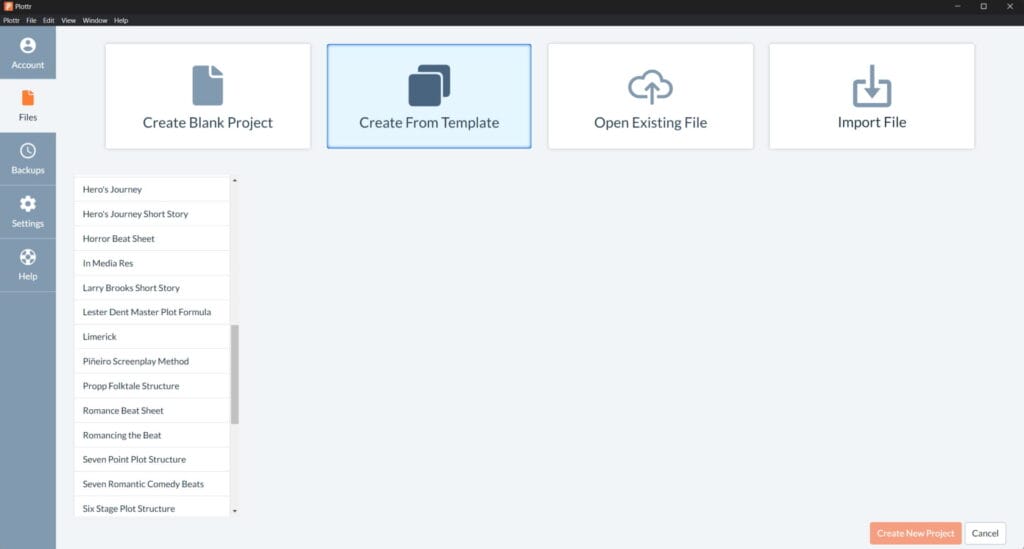
- Step 2: Scroll to the Action-Adventure Plot template and click that, then Create New Project
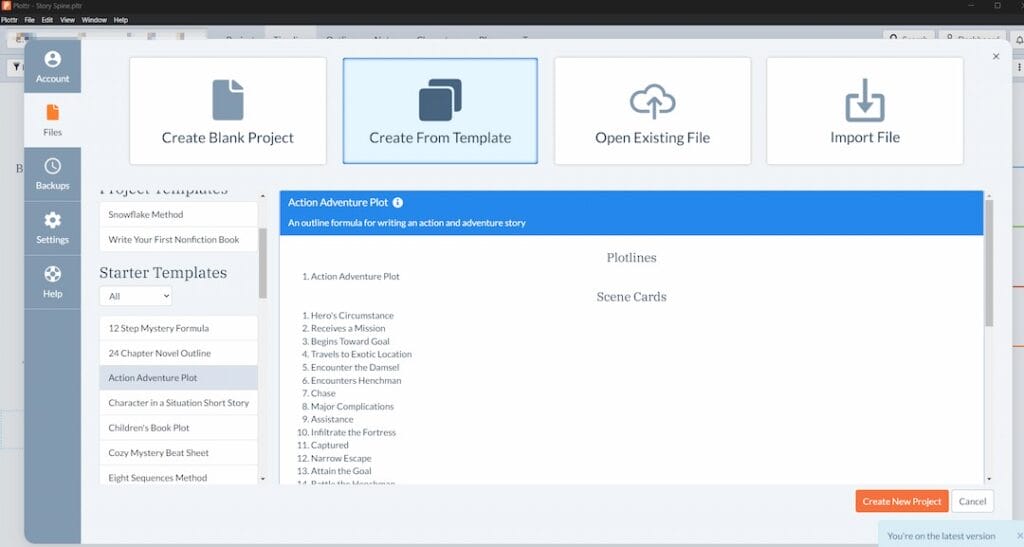
- Step 3: After you name your project, it will open in Timeline view where you’ll see the scene cards for an action-adventure story
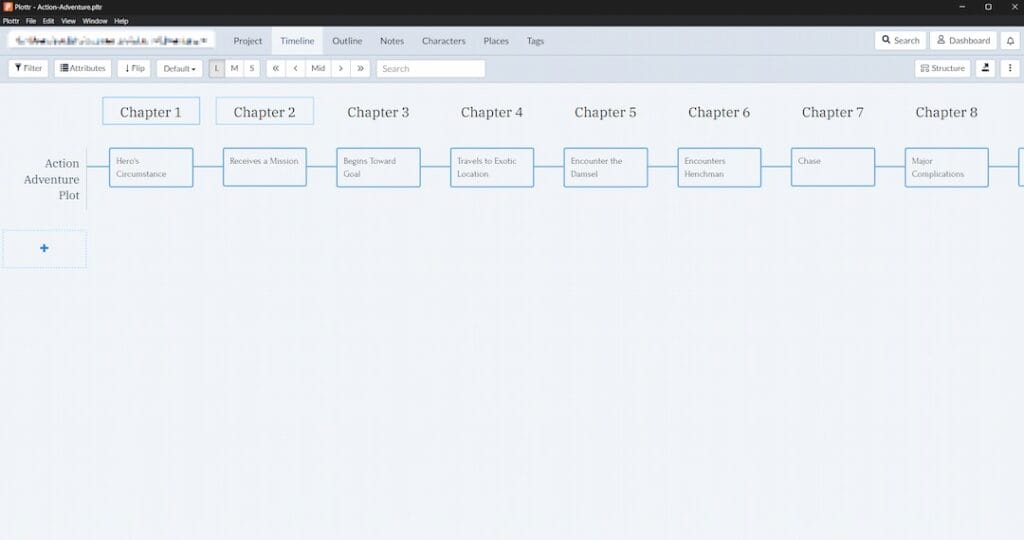
- Step 4: Click any of the scene cards to begin adding your plot points (you can remove the default text explaining each beat, or add your text above the line indicated to keep a reference guide for each scene)
You can also combine plot templates in Plottr, and these could be useful for creating subplots or simultaneous events on another timeline (such as a villain or rival’s progress):
Let’s Go Adventuring
To use the Action-Adventure Plot Template for your novel, screenplay or video game, download a free trial of Plottr and install it on your computer. You can also attend free Plottr tutorials on Tuesdays to learn how to plot awesome adventures.
Have you tried the Action-Adventure Plot Template? Tell us about it in the comments!




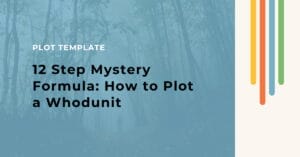




Comments